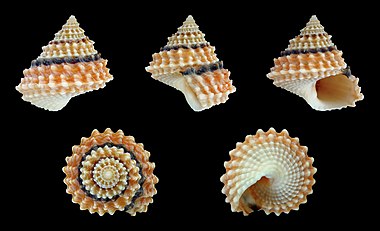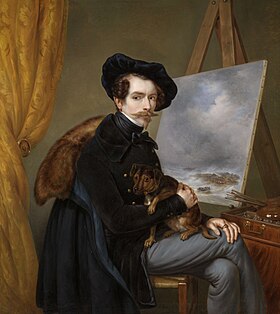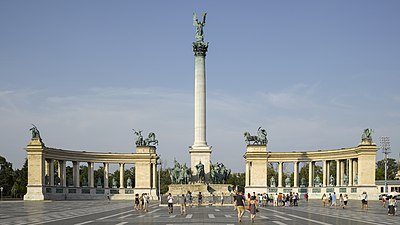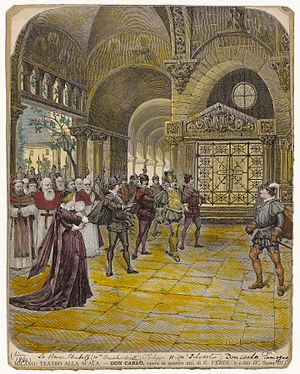|
Featured picture tools: |
These featured pictures, as scheduled below, appeared as the picture of the day (POTD) on the English Wikipedia's Main Page in March 2018. Individual sections for each day on this page can be linked to with the day number as the anchor name (e.g. [[Wikipedia:Picture of the day/March 2018#1]] for March 1).
You can add an automatically updating POTD template to your user page using {{Pic of the day}} (version with blurb) or {{POTD}} (version without blurb). For instructions on how to make custom POTD layouts, see Wikipedia:Picture of the day.Purge server cache
March 1

|
Kushari is an Egyptian dish made with a mixture of rice, macaroni, and lentils, which is topped with a spiced tomato sauce and garlic vinegar and garnished with chickpeas and crispy fried onions. A sprinkling of garlic juice, or garlic vinegar, and hot sauce are optional. Originally made in the 19th century, the dish draws influence from Indian and Italian cuisine. Photograph: Dina Said |
March 2

|
Mr and Mrs Atherton, a conversation piece completed c. 1743 by the British painter Arthur Devis (1712–1787). A student of the Flemish painter Peter Tillemans, Devis began his career as a landscape artist but had gravitated to portrait painting and established a studio in London by 1737. After a period of some success, he was unable to compete with fellow portraitists such as Joshua Reynolds and Johan Zoffany and focused on restoring paintings. Painting: Arthur Devis
Recently featured:
|
March 3

|
Tectarius coronatus is a species of sea snail native to the Philippines and Sulawesi. It has a light orange or pale brown shell that may reach 20–40 mm (0.8–1.6 in) in size. Photograph: H. Zell
Recently featured:
|
March 4

|
Iris Pruysen, an athlete with an artificial leg, competes in the long jump at the 2014 Athletics Paralympic Meeting in Stade Sébastien Charléty, Paris, France. Disabled sports, also known as parasports, are sports played by persons with a permanent or temporary disability, be it physical or intellectual. Many disabled sports are based on existing able bodied sports, modified to meet the needs of persons with a disability. However, several sports have been specifically created for persons with a disability. Photograph: Pierre-Yves Beaudouin
Recently featured:
|
March 5

|
A ten Canadian dollar note, dated 1935. The first note of the 1935 issue by the Bank of Montreal, it depicts J. Dodds and C.B. Gordon with their signatures. The building on the reverse is now part of the Hockey Hall of Fame. For more than a century, chartered banks were allowed to issue banknotes for domestic use. After the Bank of Canada was established in 1934, it took over the federal issuance of notes; chartered banks were prohibited from issuing their own currency in 1944. Banknote: Bank of Montreal (image courtesy of the National Numismatic Collection, National Museum of American History)
Recently featured:
|
March 6

|
William Tell Told Again is a 1904 retelling of the William Tell legend in prose and verse. The main prose element was written by P. G. Wodehouse, while the verse was written by John W. Houghton. The book includes a frontispiece and 15 full-page illustrations, all in colour, by Philip Dadd. Illustration: Philip Dadd; restoration: Adam Cuerden |
March 7

|
A set of lettering guides, ranging from 2.5 to 7 mm. Such guides are templates, consisting of a sheet of plastic or other material with carved alphabet letters and other shapes, used to write uniform characters in a drawing nameplate. Although since superseded in many areas by computers, for decades they were essential for lettering nameplates and helping illiterate or semi-illiterate people improve their handwriting. Photograph: Lucasbosch |
March 8

|
Ruby Loftus Screwing a Breech Ring is a 1943 painting by the British painter Laura Knight depicting a young woman, Ruby Loftus (1921–2004), working at an industrial lathe as part of the British war effort in World War II. The painting was commissioned by the War Artists' Advisory Committee, and is now part of the Imperial War Museum's art collection. The painting brought instant fame to Loftus, and has been likened to the American figure of "Rosie the Riveter". Painting: Laura Knight
Recently featured:
|
March 9

|
Louis Meijer (1809–1866), a Dutch painter, etcher, lithographer, and draftsman, as depicted in an 1838 self-portrait. Meijer, who studied under Pieter Westenberg and Jan Willem Pieneman, is best remembered for his seascapes. Painting: Louis Meijer
Recently featured:
|
March 10

|
Pretty Nose (c. 1851 – after 1952) was an Arapaho woman, and according to her grandson, a war chief who participated in the Battle of the Little Bighorn in 1876. This 1879 collotype was taken at Fort Keogh, Montana, and shows Pretty Nose wearing a cloth dress with woven cloth belt and buffalo robe, as well as earrings, bracelet, rings and necklace. Photograph: Laton Alton Huffman
Recently featured:
|
March 11

|
The griffon vulture (Gyps fulvus) is a Old World vulture in the bird of prey family Accipitridae. Specimens average 93–122 cm (37–48 in) long, with a 2.3–2.8 m (7.5–9.2 ft) wingspan. Like other vultures, the griffon vulture is a scavenger, feeding mostly from carcasses of dead animals which it finds by soaring over open areas. Photograph: Pierre Dalous
Recently featured:
|
March 12

|
John Lorimer Worden (1818–1897) was a navy officer in the American Civil War. He is remembered for commanding the Union ship USS Monitor at the Battle of Hampton Roads, the first engagement between ironclad steamships, during the American Civil War. On March 9, 1862, Worden took the Monitor to challenge the Confederate vessel Virginia, a converted steam-frigate that had sunk a Union blockader and damaged two others. After a four-hour battle, both ships withdrew, unable to pierce the other's armor. In recognition of the battle, the state of New York granted Worden a custom-made gold and silver inlaid sword. Photograph: Mathew Brady; restoration: Adam Cuerden
Recently featured:
|
March 13

|
Polypogon monspeliensis is a species of grass. It is native to southern Europe, but it can be found today throughout the world as an introduced species and sometimes a noxious weed. Photograph: Morray
Recently featured:
|
March 14

|
|
Albert Bridge is a road bridge over the River Thames in West London, connecting Chelsea to Battersea. Designed in 1873 as a cable-stayed bridge, it proved structurally unsound, and thus between 1884 and 1887 some design elements of a suspension bridge were incorporated. In 1973 two concrete piers were added, transforming the central span into a simple beam bridge. It remains one of only two Thames road bridges in central London never to have been replaced, and features the only surviving examples of bridge tollbooths in London. Photograph: David Iliff
Recently featured:
|
March 15

|
Hősök tere is a major square in Budapest, Hungary, known for its statue complex featuring the Seven Chieftains of the Magyars and other national leaders, as well as the Tomb of the Unknown Soldier. The square lies at the outbound end of Andrássy Avenue next to City Park. It hosts the Museum of Fine Arts and the Hall of Art. The square has played an important part in modern Hungarian history and has been a host to many political events, such as the reburial of Imre Nagy in 1989. Photograph: Andrew Shiva
Recently featured:
|
March 16

|
Interior with Young Woman Seen from the Back is an oil painting on canvas completed by the Danish artist Vilhelm Hammershøi c. 1903–04. Typical of his work in its use of a muted grey-blue palette, uncluttered composition, and detailed attention to the play of light; it depicts his wife, Ida, facing away from the viewer. The painting is held at the Randers Museum of Art in Randers, Denmark. Painting: Vilhelm Hammershøi
Recently featured:
|
March 17

|
The Aviat Eagle II (previously the Christen Eagle II) is an aerobatic sporting biplane aircraft produced in the United States since the late 1970s. Designed by Frank Christensen and first flown in March 1977, over 350 Eagles in three variants were flying by 2011. The aircraft is marketed in kit form for homebuilding. Photograph: Julian Herzog
Recently featured:
|
March 18

|
John C. Calhoun (1782–1850) was an American statesman and political theorist from South Carolina, and the seventh vice president of the United States from 1825 to 1832. He is remembered for strongly defending slavery and for advancing the concept of minority rights in politics, which he did in the context of defending white Southern interests from perceived Northern threats. He began his political career as a nationalist, modernizer, and proponent of a strong national government and protective tariffs. By the late 1820s, his views reversed and he became a leading proponent of states' rights, limited government, nullification, and opposition to high tariffs. His beliefs and warnings heavily influenced the South's secession from the Union in 1860–1861. Painting: George Peter Alexander Healy
Recently featured:
|
March 19

|
The rock ptarmigan (Lagopus muta) is a medium-sized gamebird in the grouse family. Averaging 34–36 cm (13–14 in) long, with a wingspan of 54–60 cm (21–24 in), this species feeds primarily on birch and willow buds and catkins. The rock ptarmigan breeds across arctic and subarctic Eurasia and North America and commonly has up to six chicks. Photo: Daiskue Tashiro
Recently featured:
|
March 20

|
The Acacus Mountains are a mountain range in western Libya, part of the Sahara. Situated east of the city of Ghat, they stretch north from the border with Algeria, about 100 kilometres (60 mi). The mountains have a large variation of landscapes, from different-coloured dunes to arches, gorges, isolated rocks and deep wadis. The area has a particularly rich array of prehistoric rock art. Photograph: Pir6mon
Recently featured:
|
March 21

|
The Virgin Mary Triumphing over Heresy and Fall of the Rebel Angels is the ceiling fresco of the Santa Maria della Vittoria, a Roman Catholic titular church dedicated to the Virgin Mary. Located in Rome and completed in 1620, it is the only structure designed and completed by the early Baroque architect Carlo Maderno. The fresco was executed by Giovanni Domenico Cerrini in 1675. The church is also known for Ecstasy of Saint Teresa, a masterpiece by Gian Lorenzo Bernini in the Cornaro Chapel, completed in 1652. Photograph: LivioAndronico |
March 22

|
Braxton Bragg (1817–1876) was a senior officer of the Confederate States Army. Born in Warrenton, North Carolina, Bragg was educated at West Point and became an artillery officer. He served in Florida, the Mexican–American War, and the Indian Territory before resigning. After some time as a sugar plantation slave owner in Louisiana, Bragg sided with the Confederate States of America and joined its army. During the course of the American Civil War, he trained troops, attempted an invasion of Kentucky and fought a number of battles. From February 24, 1864 until January 13, 1865, he was assigned to duty at Richmond, under direction of the President of the Confederate States of America Jefferson Davis, and was charged with the conduct of military operations. Photograph: Unknown; restoration: Adam Cuerden |
March 23

|
The Kiss is an oil painting on canvas completed by the Norwegian symbolist artist Edvard Munch in 1897. Part of his Frieze of Life, which depicts the stages of a relationship between men and women, The Kiss is a realization of a motif with which he had experimented since 1888/89: a couple kissing, their faces fusing as one in a symbolic representation of their unity. Exhibited as early as 1903, this work is held at the Munch Museum in Oslo. Painting: Edvard Munch |
March 24

|
A lithograph by Sidney Hall, published in Urania's Mirror, depicting the constellation Scorpius. One of the 48 constellations identified by the Greek astronomer Ptolemy in the second century, Scorpius lies between Libra to the west and Sagittarius to the east. It contains 18 main stars, the brightest of which is Antares. Although frequently identified as a scorpion, this constellation has also been likened to a "leaning coconut tree" (Java) or "Maui's fishhook" (Hawaii). Lithograph: Sidney Hall; restoration: Adam Cuerden
Recently featured:
|
March 25

|
Turmeric (Curcuma longa) is a rhizomatous herbaceous perennial plant of the ginger family. Plants are gathered annually for their rhizomes, which when not used fresh are boiled in water, dried, and ground into a deep-orange-yellow powder. Turmeric is commonly used as a coloring and flavoring agent in many Asian cuisines, especially for curries. Photograph: Simon A. Eugster
Recently featured:
|
March 26

|
An 1884 illustration by Carlo Cornaglia of the Milan premiere of Don Carlos. This grand opera, composed by Giuseppe Verdi to a French-language libretto by Joseph Méry and Camille du Locle, is adapted from Friedrich Schiller's dramatic play Don Carlos and tells the conflicts of Carlos, Prince of Asturias (1545–1568). First performed in 1867, the opera exists in numerous versions, the longest of which lasts four hours. Illustration: Carlo Cornaglia; Engraving: Giuseppe Barberis; restoration: Adam Cuerden |
March 27

|
Virgin of the Rocks is a title given to two paintings by Leonardo da Vinci, which depict the Madonna and Christ Child with the infant John the Baptist and an angel in a rocky setting. The version generally considered the prime version hangs in the Louvre in Paris; the other, shown here, is held by the National Gallery in London. Although the paintings are similar in many ways, they differ in the gaze and right hand of the angel, as well as the colours, the lighting, the flora, and the way sfumato is used. Painting: Leonardo da Vinci
Recently featured:
|
March 28

|
Iman Budhi Santosa (b. 1948) is an Indonesian author based in Yogyakarta. Born in Magetan, East Java, he was educated in agriculture but drawn to literature from a young age. In 1969, he helped establish the Persada Studi Klub, later publishing numerous works, including poetry collections, novels, and short stories. His poetry has been considered to have strong Javanese cultural influences. Photograph: Chris Woodrich
Recently featured:
|
March 29

|
Police Commissioner Suleiman Kova answers questions and addresses the media at the site of the 2013 collapse of a 16-storey residential apartment building in Dar es Salaam, Tanzania, onto a nearby mosque compound. The disaster killed 36 people, and over 60 were trapped under the rubble. Photograph: Muhammad Mahdi Karim
Recently featured:
|
March 30

|
Kue gapit is an Indonesian kue kering (dry snack) which originates from Cirebon, West Java. Generally made from tapioca flour, its name comes from the cooking process, in which it is grilled between iron molds. The snack comes in a variety of shapes and flavors. Though it is a popular souvenir among visitors to Cirebon, residents of the region rarely eat it. Shown here is a whole and partial kue gapit. The upper scale mark shows 1 cm while the lower one is 1 inch. Photograph: Chris Woodrich |
March 31
|
He-gassen is a Japanese art scroll created during the Edo period by one or more unknown artists. It depicts various scenes, all of which depict at least one character directing flatulence against other characters. The scroll, which measures 29.6 cm × 1003.1 cm (11.7 in × 394.9 in), may have been made in response to political and social change in Japan following the arrival of outside cultures. Painting: Unknown (image courtesy of the Waseda University Library) |
Picture of the day archives and future dates
